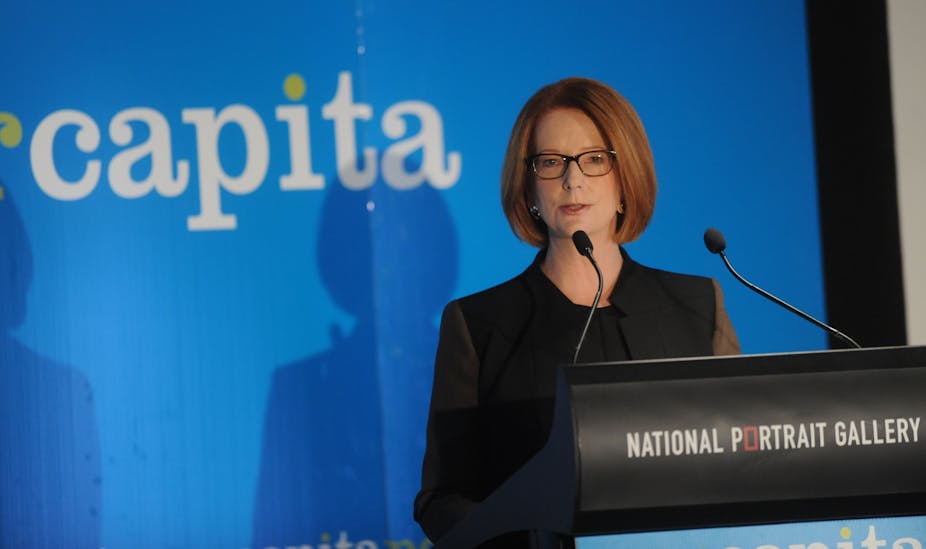Last week NSW signed up to the Gillard government’s proposed changes to school funding – a deal that would see a new funding model based on the Gonski review and an injection of A$5 billion into NSW schools.
But yesterday the Prime Minster announced a A$12 billion black hole in the budget, starting speculation about whether the new reforms were affordable.
In a speech in Canberra she said, “better school funding and school improvement would not be jeopardised.” But tightening budgets aren’t the only thing that could put school funding reform in danger.
Since the Gonski review was publicly released almost two years ago, schools funding reform has had a bumpy ride. The dynamics of a federated political system, a knife-edge parliament and the cycles of elections, have all created uncertainty.
While one state has signed up, and more may do so, the future of the reforms remain unclear.
The review
The Gonski Review, the first major national review of school funding in almost 40 years, identified a number of issues with the current education system.
While Australia does well on some international measures, such as Programme for International Student Assessment or PISA tests, there are large gaps between students based on social background, ethnicity, race and where students live. Enduring structural issues, linked to poverty and divisions in provision, and inadequate and poorly targeted funding all contribute to this inequity.
The Gonski remedy was to substantially increase funding with boosted loadings to target schools serving disadvantaged students with high level needs.
While increased funding alone, as many commentators point out, doesn’t guarantee improvement, funding is essential to providing schools with the means they need to support transformation.
Keeping Gonski alive
This basic premise and model recommended by the Gonski panel then fed into the government’s National Plan for School Improvement which is currently being offered up to the states for agreement.
At a time when extra investment in schools is well overdue, it’s still unclear whether any more states will sign up or what an election in September will bring.
One possibility is that all of the states and territories sign up by the middle of the year, or that enough of them do to make any wind-back untenable. This scenario should see major injections of funds to Australian schools, particularly government schools serving disadvantaged communities.
This would surely help such schools which have seen equity funding over recent decades keep pace with inflation but not keep pace with the levels of escalating need.
It is still not clear, though, that the additional funding would be sufficient to meet the levels of need, and drive the necessary improvements in performance, for a couple of reasons.
Gonski estimated for 2009 an additional A$5 billion to meet need per year, while the current offer involves only about half of that amount annually.
On top of this, the Australian government’s insistence that under the new funding arrangement no school will lose any recurrent per capita funds, may see a watering down of the provisions for the most disadvantaged schools.
In the drive to ensure no school loses, the criteria for disadvantage may need to be diluted, and funds spread more thinly. It will be a big question whether there will be enough to meet the real extent of need.
A Coalition repeal?
Another possibility is that the remaining states don’t sign up or, even if they do, the federal election brings a new government hell bent on constraining budgets and limiting outlays.
Both opposition leader Tony Abbott and shadow education minister Christopher Pyne in recent statements have reiterated their desire to ignore the Gonski reforms, or repeal them, and retain the previous funding model, even if there’s only one state that didn’t sign up by election time.
This would be a huge setback. Disadvantaged schools would not only lose the National Partnership funds that have helped generate innovative reforms, they would also be forced to return to a funding model that has delivered large gaps in student outcomes between schools and communities.
This may mean that our neediest schools are actually worse off than before, having lost National Partnerships funding, gained no increases in additional funding, reliant on a model that has failed to allow them to adequately address need, and with gaps between them and wealthier schools as big as ever.
And it is quite possible that not all states will sign on to the Gonski reforms.
The model set out in the review establishes a per capita national resource standard, based on average costs and outlays, with supplementary loadings to address need.
The standard does not recognise differences across jurisdictions in salary rates, leaving states and territories such as West Australia and the Northern Territory at a disadvantage. Nor does it recognise all of the real additional imposts of schooling in remote areas, and in heavily disadvantaged communities.
Politics before education
Whatever transpires it is clear that politics continues to get in the way of national interest.
World class education systems are those in which students consistently learn and achieve to high standards, and the standards extend across the population, making sure all students benefit.
Heavy investment in schools serving our most disadvantaged students and families, as recognised in the Gonski Review, is needed to achieve this.
No one doubts the need for fiscal restraint in times of economic contraction and uncertainty, but long overdue school funding reform (and university and TAFE investment) should not be part of the sacrifice in the drive to bring budgets back into the black.

